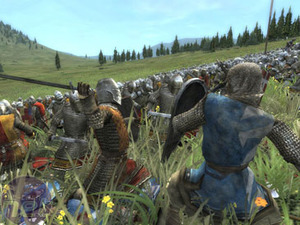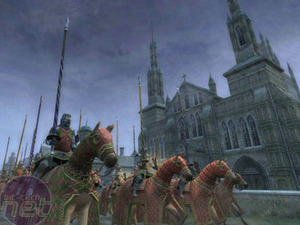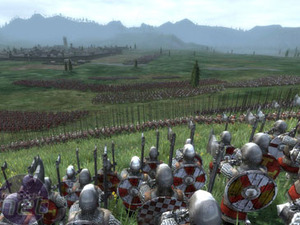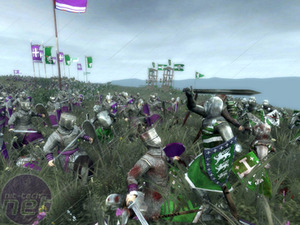Dope Pope
Another new addition that you will bump into pretty quickly are the limits on troop recruitment. At the beginning of the game, when your cities and castles are all fairly basic, the number of troops you can recruit will be quite limited, for instance to begin you will only be able to recruit three types of any specific unit. The only way to increase the amount of troops you can recruit is by conquering more cities (watch out Scotland), building more military buildings (such as stables and barracks) or by recruiting the expensive mercenary units. I decided to take a trip North and quickly trounced the Scots out of the game, nabbed Edinburgh and Inverness and then a quick boat ride later I was in possession of Dublin too. Guinness all round!Some Total War fans will be left a little miffed at the decision to limit the number of troops. In previous games one effective way of emerging victorious was by monopolising trade and then, once you were as rich as Bill Gates, building an army that can smash your foes. Not any more. The new limitations placed on troop recruitment keeps the game from being easily beaten and slows everything down. I was worried about limits but was pleasantly pleased with their effect on the overall game.
Creative Assembly hasn't stopped there either. The Pope returns once again, making demands and calling for Crusades like he's the son of God or something. He's far more influential in this game than the previous Medieval and it's a necessity to keep him on your side especially in the early part of the campaign. Refuse to go on a Crusade or disobey an order to stop attacking a fellow Christian nation and you could end up excommunicated. Before you know it that Crusade which you refused to go on four turns earlier could soon be turned on your capital city.
The effect of having a more dominating Pope ultimately stifles your ability to mow through the entirety of Europe and makes the game far more realistic. Had one nation got overly powerful in the middle ages then the only way to stop them would have been a coalition. The Pope acts as the middle man here making it difficult, though not impossible to gain supremacy over Europe.
I say not impossible because you can, in a way, gain control of the Papal seat. One of the other new units is the Priest, which you use to spread the Catholic word, to root out heretics and keep the Pope happy. Get enough of your Priests to Cardinal status and you could find one of them becomes the Pope. If this happens then you'll be able to influence when Crusades happen, who gets excommunicated and put yourself in a pretty safe position. Other Kings are trying to do the same thing and should you fail then you better hope you're in the good books of whichever side gets into power.
The 2D map section maintains the flashy graphics seen in Rome Total War but is essentially the same as it has always been. You still can't control the outcome of naval battles, they are all automated, characters and armies have a limited distance they can travel and sieges and battles work by just colliding the two warring parties with one another.
All this rather excited talk and we've only discussed 50% of the game. The real crowd drawer, though not necessarily the best aspect of the game, will be the absolutely mahoosive battles that you can fight in.
The art of war
For some bizarre reason, in the game that I played the Danish decided to stick up for the French and sparked up a war against me that I wasn't expecting. Being the tactical genius that I am I always had a contingency plan. I landed a gigantic army behind the Danish troops that were assaulting my new found foothold in Northern France and so began an epic series of battles all the way across the continent of Europe.If you haven't played the game before I'll provide an explanation to how the battles work. Medieval 2 is closer to a game of chess than it is to a traditional RTS, with battles moving far slower that other RTS games. Each battle starts with you having the option of laying out your army in the way you want. Traditionally your ranged fighters, archers and artillery will be protected by your spear and swordsmen whilst your cavalry is usually used to flank the enemy.
Moving the forces is a simple case of highlighting them and then right clicking once for walk or twice for run. When facing off against an enemy you generally end up lining up opposite one another with scenes that will remind you of movies like Braveheart (minus the mooning – surely someone has to make a modification for the Scots to be able to flash their bums). The two armies will clash together and so the fighting begins.
Creative Assembly has placed a lot of emphasis on the additional animations for the units within the armies. Their hope was to move away from the clone like moves that your troops use to perform to make the fights to the death seem more organic and realistic. This affect has been achieved to a certain extent though still has a long way to go before it comes close to matching the spectacular battles seen in movies like Gladiator or Alexander.
The format for the battles is similar to previous iterations. Spearmen beat cavalry, cavalry beat swordsmen and swordsmen beat spearmen. Essentially this is rock, paper, scissors with the archers and artillery waiting on the sidelines throwing rocks and nasty objects and running away if anyone comes near them. Flanking and outnumbering your opponent are the best ways of securing victory alongside battlefield tactic staples such as 'hold the high ground' and 'ambush them by hiding in the trees' – all of which hold true in Medieval 2.

MSI MPG Velox 100R Chassis Review
October 14 2021 | 15:04














Want to comment? Please log in.